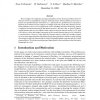Free Online Productivity Tools
i2Speak
i2Symbol
i2OCR
iTex2Img
iWeb2Print
iWeb2Shot
i2Type
iPdf2Split
iPdf2Merge
i2Bopomofo
i2Arabic
i2Style
i2Image
i2PDF
iLatex2Rtf
Sci2ools
FSTTCS
1993
Springer
1993
Springer
Compact Location Problems
We investigate the complexity and approximability of some location problems when two distance values are specified for each pair of potential sites. These problems involve the selection of a specified number of facilities (i.e. a placement of a specified size) to minimize a function of one distance metric subject to a budget constraint on the other distance metric. Such problems arise in several application areas including statistical clustering, pattern recognition and load–balancing in distributed systems. We show that, in general, obtaining placements that are near-optimal with respect to the first distance metric is £¥¤ –hard even when we allow the budget constraint on the second distance metric to be violated by a constant factor. However, when both the distance metrics satisfy the triangle inequality, we present approximation algorithms that produce placements which are near-optimal with respect to the first distance metric while violating the budget constraintonly b...
| Added | 09 Aug 2010 |
| Updated | 09 Aug 2010 |
| Type | Conference |
| Year | 1993 |
| Where | FSTTCS |
| Authors | Venkatesh Radhakrishnan, Sven Oliver Krumke, Madhav V. Marathe, Daniel J. Rosenkrantz, S. S. Ravi |
Comments (0)

